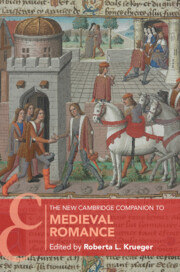Book contents
- The New Cambridge Companion to Medieval Romance
- The New Cambridge Companion to Medieval Romance
- Copyright page
- Contents
- Figures
- Contributors
- Acknowledgments
- Chronology
- Introduction
- 1 “For Love and For Lovers”
- 2 The Manuscript Contexts of Medieval Romance
- 3 Matters of Form
- 4 Authors, Narrators, and Their Stories in Old French Romance
- 5 Arthurian Transformations
- 6 Romance and the Medieval Mediterranean
- 7 The Crusading Romance in Britain
- 8 “Making Race” in Medieval Romance
- 9 The Construction and Interrogation of Gender in Old French Romance
- 10 Emotions as the Language of Romance
- 11 Medieval Iberian Romance
- 12 Medieval and Early Modern Italian Romance
- 13 German Medieval Romance
- 14 The Ends of Romance in Chaucer and Malory
- 15 French Romance in the Late Middle Ages and the Renaissance
- 16 Romance in Historical Context
- 17 Romance in Twentieth- and Twenty-First-Century Popular Culture
- Bibliography of Editions and Translations
- Index
- Cambridge Companions To …
- References
17 - Romance in Twentieth- and Twenty-First-Century Popular Culture
Published online by Cambridge University Press: 11 May 2023
- The New Cambridge Companion to Medieval Romance
- The New Cambridge Companion to Medieval Romance
- Copyright page
- Contents
- Figures
- Contributors
- Acknowledgments
- Chronology
- Introduction
- 1 “For Love and For Lovers”
- 2 The Manuscript Contexts of Medieval Romance
- 3 Matters of Form
- 4 Authors, Narrators, and Their Stories in Old French Romance
- 5 Arthurian Transformations
- 6 Romance and the Medieval Mediterranean
- 7 The Crusading Romance in Britain
- 8 “Making Race” in Medieval Romance
- 9 The Construction and Interrogation of Gender in Old French Romance
- 10 Emotions as the Language of Romance
- 11 Medieval Iberian Romance
- 12 Medieval and Early Modern Italian Romance
- 13 German Medieval Romance
- 14 The Ends of Romance in Chaucer and Malory
- 15 French Romance in the Late Middle Ages and the Renaissance
- 16 Romance in Historical Context
- 17 Romance in Twentieth- and Twenty-First-Century Popular Culture
- Bibliography of Editions and Translations
- Index
- Cambridge Companions To …
- References
Summary
This chapter illustrates the cycle of adaptation, consumption, and production by which the medieval romance genre has sustained itself over time to remain vital in multiple national traditions: French adaptations of Tristan and Isolde and Arthurian romances, Germany’s continuing engagement with the Siegfried legend, Italian novels, such as those written by Umberto Eco and Italo Calvino, Spanish adaptations of Don Quixote and El Cid, and the long Anglo-American love affair with the medieval past. After an examination of the unique intersection of genre, story world, and media that makes medieval romance so infinitely adaptable, the chapter focuses on a series of post–World War II Anglo-American adaptations of the Arthurian legend. These texts, beginning withThe Adventures of Sir Galahad (1949) and concluding with The Green Knight (2021), each produced at a moment when either cultural context or technological innovation provided the impetus for a new Arthurian adaptation, mobilized the romance genre’s adaptive potential and deployed new media and technologies to attract the attention of audiences and critics. As they did so, they brought the narrative back into the cultural conversation, inspired other producers to seek to capitalize on King Arthur’s popularity, and ensured the continuing vitality of medieval romance.
- Type
- Chapter
- Information
- The New Cambridge Companion to Medieval Romance , pp. 257 - 271Publisher: Cambridge University PressPrint publication year: 2023

